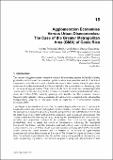| dc.contributor.author | Pichardo Muñiz, Arlette | |
| dc.contributor.author | Otoya Chavarría, Marco | |
| dc.date.accessioned | 2020-09-23T17:15:02Z | |
| dc.date.available | 2020-09-23T17:15:02Z | |
| dc.date.issued | 2012-03-21 | |
| dc.identifier.isbn | 978-953-51-0377-6 | |
| dc.identifier.isbn | 978-953-51-6161-5 | |
| dc.identifier.uri | http://hdl.handle.net/11056/18237 | |
| dc.identifier.uri | https://www.intechopen.com/books/advances-in-spatial-planning/agglomeration-economies-versus-urban-diseconomies | |
| dc.description.abstract | The process of agglomeration economies proceeds in increasing manner, indirectly affecting
productive activities such as education, public services, transportation and all of its linked
components. Nevertheless, there is a limit to this accumulative process where the gains from
economies of scales are reversed and this is related to the accumulation of decreasing costs
in the areas of agglomeration. These costs include price of factors (i.e., commuting) with
scarcer factors (land and labor); it also includes costs related to transportation (traffic, stress,
crime, etc.) (Polèse, 1998). Generally speaking, a city, just like any other economic resource,
begins to enter a phase of decreasing returns of scale and cost of essential urban services like
transportation, adopting an U-shaped trend, as explained in microeconomic analysis
(Camagni, 2005). | es_ES |
| dc.description.abstract | El proceso de las economías de aglomeración avanza de manera creciente, afectando indirectamente actividades productivas como la educación, los servicios públicos, el transporte y todos sus componentes vinculados. Sin embargo, hay un límite a este proceso acumulativo donde las ganancias de las economías de escala se invierten y esto está relacionado con la acumulación de costos decrecientes en las áreas de aglomeración. Estos costos incluyen el precio de los factores (es decir, los desplazamientos domicilio-lugar de trabajo) con factores más escasos (tierra y mano de obra); también incluye los costos relacionados con el transporte (tráfico, estrés, delincuencia, etc.) (Polèse, 1998). En términos generales, una ciudad, al igual que cualquier otro recurso económico, comienza a entrar en una fase de rendimientos decrecientes de escala y costo de servicios urbanos esenciales como el transporte, adoptando una tendencia en forma de U, como se explica en el análisis microeconómico (Camagni, 2005). | es_ES |
| dc.description.sponsorship | Universidad Nacional, Costa Rica | es_ES |
| dc.language.iso | eng | es_ES |
| dc.publisher | IntechOpen.com | es_ES |
| dc.rights | Acceso abierto | es_ES |
| dc.rights | Atribución-NoComercial 4.0 Internacional | * |
| dc.rights.uri | http://creativecommons.org/licenses/by-nc/4.0/ | * |
| dc.source | Advances in Spatial Planning | es_ES |
| dc.subject | MACROECONOMÍA | es_ES |
| dc.subject | ECONOMÍA REGIONAL | |
| dc.subject | DESARROLLO ECONÓMICO | |
| dc.subject | CALIDAD DE VIDA | |
| dc.subject | SEGURIDAD | |
| dc.subject | COSTA RICA | |
| dc.subject | MACROECONOMICS | |
| dc.subject | REGIONAL ECONOMY | |
| dc.subject | ECONOMIC DEVELOPMENT | |
| dc.subject | LIFE QUALITY | |
| dc.subject | SECURITY | |
| dc.title | Agglomeration Economies Versus Urban Diseconomies: The Case of the Greater Metropolitan Area (GMA) of Costa Rica | es_ES |
| dc.type | http://purl.org/coar/resource_type/c_6501 | es_ES |
| dc.description.procedence | Centro Internacional de Política Económica para el Desarrollo Sostenible | es_ES |
| dc.description.procedence | Escuela de Economía (ESEUNA) | |
| dc.identifier.doi | 10.5772 / 2123 | |


